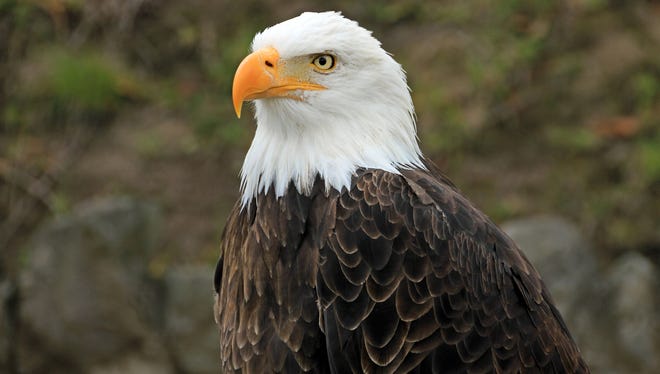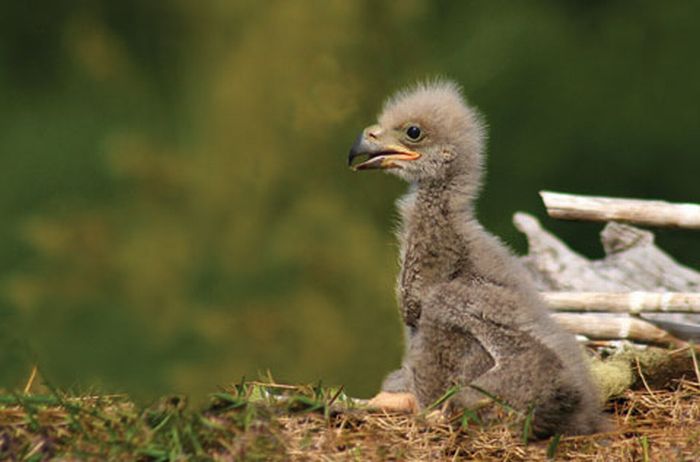18 Bald Eagle Facts That Will Make You Soar With Joy!
"Eagle Fact #1: Bald Eagles are not actually bald.
...The name comes from an old English word from centuries ago: Piebald, which is defined as “having irregular patches of 2 colors, typically black & white.”
Being the national symbol of the United States since 1782 has garnered these avians a lot of attention over the years. Eagles appear everywhere, from one-dollar bills to the president’s flag, making it the most pictured bird in the country, even beating out Northern Cardinals on Christmas cards.
But there was one founding father of America that didn’t specifically like the Bald Eagle. That was Benjamin Franklin.
We know this because Franklin wrote a letter to his daughter, where he said, 'I wish the Bald Eagle had not been chosen the Representative of our Country. He is a Bird of bad moral Character. He does not get his Living honestly.' The reason for this strong statement is that Ben had witnessed eagles stealing fish from Ospreys after they made a successful kill.
Franklin was more in favor of a Turkey being the National Bird, saying the 'Turkey is in Comparison a much more respectable Bird, and withal a true original Native of America… He is besides, though a little vain & silly, a Bird of Courage, & would not hesitate to attack a Grenadier of the British Guards who should presume to invade his Farm Yard with a red Coat on.'...
Their average life span in the wild is 20 years, but the oldest recorded bird was 38! Captive individuals have been known to live longer, with one eagle almost reaching the age of 50.
Eagle Fact #4: They embrace strong family values
Eagle pairs typically bond for life. When breeding season arrives each year, the same pair meet, build (or reuse) a nest, & raise up to 3 young. Both eagles help raise the babies, with each sitting on eggs, & hunting & providing food for the young.
The concern for their young is so strong that they walk around the nest by folding their talons in so that they won’t accidentally hurt the young birds.
When Bald Eagles are not breeding, they tend to be solitary, self-reliant, & independent.
A Bald Eagle’s typical wingspan is between 5 ft 11 in (1.8m) & 7 ft 7 in (2.3 m).
...Eagles only weigh around 10 pounds and are 3 feet long!
Eagle Fact #6: It takes 5 years to become an adult.
You probably think that identifying a Bald Eagle is easy with their dark bodies, yellow talons, & distinctive white heads.
Well, you would be right as long as it’s an ADULT eagle. Juveniles are INCREDIBLY hard to identify correctly. And the problem is that adult colors don’t manifest themselves until the 5th year.
Juveniles are (generally) uniformly brown during the first year. Then during the second year, they start to have flashes of white on the underwing & the bottom of the tail feathers, with tan chests that include light-colored speckles. Not to mention the beak is black as night.
During the 3rd and 4th years, the youngsters will still be speckled with white all over. At least at this point, they will be approaching what we typically recognize as Bald Eagle coloration, although the beaks are still dark, & the face may sport a brown brow line that reminds you more of an osprey.
Unfortunately, none of the above is a hard & fast rule, & there are many variations of different colored underwings, chests, & tail feathers...
Eagle Fact #7: The iconic eagle scream is FAKE.
Just imagine what you think a Bald Eagle sounds like. I’m sure you have heard one in a movie somewhere. As soon as it spots its prey, the eagle lets out a death call that strikes fear...
Would you believe me if I told you that the sound... wasn’t from a Bald Eagle? That audio clip came from a Red-tailed Hawk...the actual calls of a Bald Eagle aren’t so impressive. I think they sound more like a giggling seagull than a scary raptor...
Eagle Fact #8: Their nests are HUGE!
Believe it or not, Bald Eagles make the most massive tree nests ever recorded for any animal species! The largest nest documented was 9.5 feet in diameter, 20 feet deep, & weighed almost 3 tons...
The average nest is about 4 to 5 feet in diameter & 2 to 4 feet deep. Each year, the adult breeding pairs add to the previous year’s nest, typically adding about 1-2 feet of new material. Eagle nests usually don’t last past 5 years because they collapse from their immense weight in the tree.
Bald Eagles are not that selective about which type of tree they build their nest in, as long as the location is open, has excellent visibility, is over 66 feet high (20 meters), & is near food...
Once an egg hatches, the baby eagle will be confined to the nest anywhere between 8 to 14 weeks before fledging (taking their first flight).
But even once they can fly, the parents will continue bringing the juveniles food & providing protection for another 6 weeks! During this time, they continue to develop their flying & hunting skills before heading off on their own.
So, from hatching to leaving their parents, Bald Eagles spend a few months with their babies. As far as birds go, this is an incredibly long amount of time!
As with many other animals, the highest likelihood of death for eagles comes in the first year, where the rate at which young birds perish is 50% or more.
The most significant risk for young eagles usually comes from their older siblings. The oldest chick almost always has the advantage of a larger size & voice, which draws the parent’s attention. This extra attention means they are usually given more food, which can lead to starvation for younger chicks.
Sometimes the oldest chick even attacks & kills the younger ones, especially right after the eggs hatch, & the size difference is most notable.
Other risks come from nest collapses, bad weather, eggs that never hatch, or predation. Animals that have been recorded preying upon baby Bald Eagles include Red-tailed Hawks, owls, large gulls, crows, ravens, magpies, wolverines, fishers, bobcats, bears, & raccoons.
Eagle Fact #11: They almost went extinct.
In the latter part of the last century, there was a lot of Dichlorodiphenyltrichloroethane (DDT for short) in the environment. DDT is an insecticide that was invented in the 1940s, & at first, it was seen as a miracle.
Unfortunately, DDT was a terrible thing for birds, particularly raptors. This harmful insecticide caused the eggs of many birds of prey to become so thin that the shell would collapse, & the young would never hatch. As you can imagine, after many years of severe infant mortality, there were massive decreases in Bald Eagle populations. During the mid-20th century, eagle populations became so low they were put on the Endangered Species List, & many people thought they would never recover.
Luckily, DDT was finally banned during the 1970s. After a lot of work by many conservation organizations, Bald Eagles & other species experienced a tremendous resurgence, & now are common across North America!
To give you some context, in 1963, there were only about 400 nesting pairs of Bald Eagles left. Now there are almost 10,000!
Some Bald Eagles have gotten themselves in a jam, at which point they needed a bit of help from some helpful humans...
In another instance, a very young eagle got stuck in a grassy portion of a lake where it was impossible to get dry enough to fly again. A passing couple managed to get the bird on their boat, where it was taken to dry land.
I love that the Bald Eagle seems to enjoy the boat ride and sits on the side the entire time. Even when they get to shore, the bird sticks around to eat a fish that the rescuers provide!
Eagle Fact #13: They are mostly pescetarians.
Bald Eagles are opportunistic feeders that prey on a wide variety of food, but their most common source of food is fish! They are expert fish hunters & have adapted to swoop down to snatch fish from the water with their talons.
Bald Eagles are also known to eat other birds, mammals, and even carrion.
Studies have found that an eagle’s diet consists of approximately 56% fish, 28% birds (mostly waterbirds such as ducks), 14% mammals, & 2% other prey.
Eagle Fact #14: They only live in North America.
Bald Eagles are the only eagles that are found only in North America.
They have a wide range across the continent, which includes most of Canada, Alaska, & all of the contiguous United States. They even can be found in northern Mexico.
Eagles are almost always found near large bodies of water where they can hunt fish & find large trees for nesting. They are found in deserts, islands, forests, mountains, & swamps. As long as there are fish to eat, it’s possible to see Bald Eagles.
Eagle Fact #15: They are one of nature’s most perfect predators.
Bald Eagles have many adaptations that make them deadly & efficient hunters.
Speed: When diving for their prey, they reach speeds between 75 – 100 miles per hour.
Talons: Their talons are incredibly strong, & their estimated gripping power is 10 times greater than a human. Bald Eagles can fly with fish at least equal to their weight. When their prey is too heavy to fly with, it’s not uncommon to see an eagle dragging it through the water to find a place that is safe to eat.
Beak: The beak is large, hooked, & strong, which helps them rip into the flesh of their prey.
Eyes: They have excellent eyesight allowing them to see small prey from very high in the sky. Eagles have a wider field of vision than humans, along with seeing ultraviolet light. The expression 'eagle eye' is spot on!
Eagle Fact #16: But they also steal food & eat trash.
Yes, Bald Eagles are deadly predators — but they don’t always catch their meals themselves.
Rather than do their own fishing, Bald Eagles often go after other creatures’ catches. For example, they will sometimes harass a hunting Osprey until the smaller raptor drops its prey in midair, where the eagle swoops it up. A Bald Eagle may even snatch a fish directly out of an Osprey’s talons!
Bald eagles will also scavenge in dumpsters, feed on waste from fish processing plants, & gorge on carrion (dead, decaying animals).
Maybe this is what Ben Franklin was referring to when he wrote that a Bald Eagle was of 'bad moral character.'
Bald Eagle courtship can be pretty dramatic, with many elaborate calls & flight displays.
But the craziest part involves the birds flying high into the sky, locking talons, & free-falling & spinning together, releasing right before they hit the ground...
Eagle Fact #18: They can gather in HUGE numbers.
During the winter months, when eagles aren’t protecting a breeding territory & food is scarce, they are known to gather in large numbers.
This phenomenon tends to happen when a reliable & consistent food source becomes available."
Scott
birdwatchinghq.com/bald-eagle-facts
Cute Critter Pics:







.jpg)
No comments:
Post a Comment